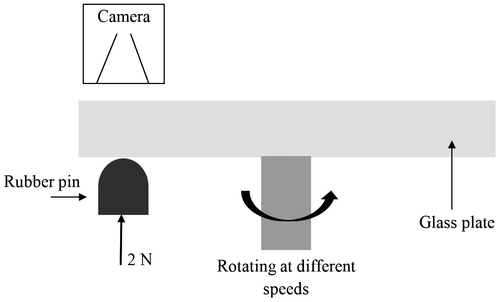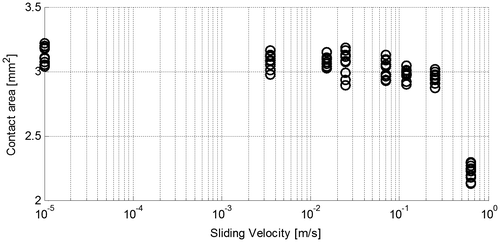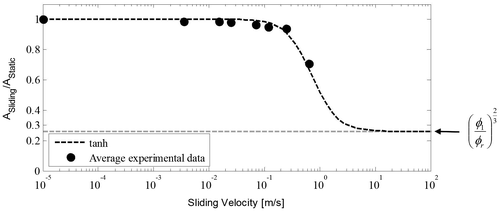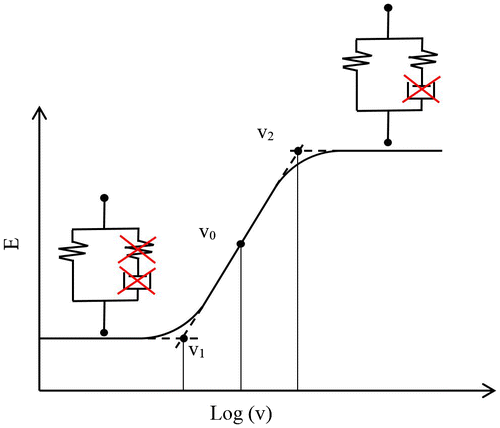Abstract
The friction in tribo-systems that contain viscoelastic materials, such as elastomers, is relevant for a large number of applications. Examples include tyres, hoses, transmission and conveyor belts. To quantify the friction in these applications, one must first understand the contact behaviour of such viscoelastic materials, both in static and in dynamic situations. This work discusses an experimental study into the change of the contact area with the sliding velocity and relates the change in contact area with the mechanical properties of the elastomer. The results show that for a tribo-system containing an elastomer, there is a threshold velocity, above which the size of the contact area significantly reduces.
1. Introduction
It is well known that for purely elastic materials, the contact area and shape during sliding remain constant and are independent of the sliding velocity.Citation1 This is, however, not the case for materials when plasticity is involved. For example, the shape of the contact area between a rigid sphere and a plastic deforming material is circular in the static case, while it is semicircular when sliding occurs. However, the size of the contact area remains constant, allowing to describe the contact behaviour during sliding from the static contact behaviour.
In the case of elastomers, both the shape and the size of the contact area during sliding differ from the static case.Citation2–7 Arvanitaki et al.Citation2 showed a reduction in the contact area and a change in the shape of the contact area with increasing velocity. At low sliding velocities, the contact is semi-static, meaning that the contact area is equal to the static contact area and, with increasing velocity, remains constant until a certain velocity is reached. At the threshold velocity, the size of the contact area starts to decrease, as described by Ludema and TaborCitation3 and Vorvolakos and ChaudhuryCitation4. According to Ludema and TaborCitation3, as the sliding velocity increases, the deformation rate increases, resulting in an increase in the stiffness of the rubber and a decrease in the contact area. Fukahori et al.Citation7 studied waves of detachment appearing in the contact area while a rigid indenter slides over an elastomer. Next to their observations that the waves of detachment appear only under certain conditions, they showed that the contact area between the elastomer and the rigid indenter changed, both in shape and in size with a varying sliding velocity in all the studied cases.
Despite that the changes in the shape and size of the contact area between an elastomer and a sliding rigid indenter are known, currently there is no general relation that allows predicting or calculating the contact area as a function of material properties and operational conditions, such as load and velocity. In this study, the effect of sliding velocity on the size of the contact area is studied and a relationship between the dynamic contact area over static contact area as a function of the sliding velocity is given.
2. Experimental method
A tribological system composed of an elastomeric spherical pin sliding against a smooth rigid glass plate is considered. The surface roughness of the smooth glass plate is 0.1 μm. The material used in this study is ethylene propylene diene rubber (EPDM). The elastic modulus of EPDM is E = 4.39 ± 0.14 MPa. The elastomeric pin has a radius R = 3 mm. Sliding experiments were performed employing a pin-on-disc set-up at an applied normal load of FN = 2 N and velocities between 3.6 and 638 mm/s. The distance between the contacting elastomeric pin and the centre of the glass plate is rtrack = 12 mm. A camera was fitted normal to the plane of contact, and pictures of the contact area were taken at different sliding velocities. A schematic illustration of the set-up is shown in Fig. .
3. Results and discussion
The set-up allows recording the contact area between the glass plate and the rubber pin in the static case and at several sliding velocities. Figure a shows the contact area in the static case. It can be seen that the contact area has a circular shape. Figure b shows the contact area at a sliding velocity of 118 mm/s, the shape of the contact area changes when sliding takes place; the contact area becomes elliptical, with the major axis normal to the sliding direction.
2 Photographs of the contact area between an elastomeric spherical indenter and a glass disc, a in static contact, b in sliding contact at 118 mm/s

The contact area was measured in the static case (i.e. at 0 mm/s) and for seven sliding velocities: 3.6, 15.2, 24.8, 70.5, 118.2, 249.8 and 638 mm/s. The contact area is measured by the relation as A = πR1R2, where R1 and R2 are obtained from the experiments (see Fig. b). An average of 10 measurements of the contact area was taken at each sliding velocity; the standard deviation is 0.06 mm2. Figure shows a plot of the results on a logarithmic scale, and the static contact is plotted at a sliding velocity of 10−5 m/s. Qualitatively, the results show a similar behaviour as those reported by Arvanitaki et al.Citation2 and Fukahori et al.Citation7. It can be seen that the contact area is fairly constant with the sliding velocity until 100 mm/s, after which it sharply drops with increasing sliding velocity.
Due to limitations of the experimental set-up, sliding velocities above 640 mm/s are not possible, so no data points could be obtained beyond this value. However, it is unlikely that the contact area would become zero for very high velocities and rather it would approach a minimum limit; therefore, a constraint to the contact area at very high sliding velocities is added. As described by JohnsonCitation8, for the contact between a rigid and an incompressible material, the contact area depends on the elastic modulus of the material and can be expressed as A ~ E−2/3. Ludema and TaborCitation3 suggested that the contact area depends on the sliding velocity in a similar way as the material properties of an elastomer depend on the frequency of deformation.
The material properties of the elastomer used in this study, EPDM, were measured in a dynamic mechanical analysis (DMA). From the measurements, the creep compliance function, φ(t), was obtained (more details on the creep compliance function can be found in the Appendix 1). Table shows the results of the experiments. Based on the previous researchCitation9, the contact area of viscoelastic material has a correlation with the creep compliance as A ≈ φ(t)2/3. Therefore, the ratio between the coefficient of the creep compliance with the smallest retardation time, φ1, and the creep compliance in the relaxed state, φr, allows obtaining the minimum limiting value for the contact area at a high sliding velocity. The ratio is given by:
(1)
This means that the contact area at very high sliding velocities is Av≫1 m/s = 0.26 Astatic for the material used in this study. Adding this new constraint to the dimensionless (averaged) measured data points at each velocity gives the fit represented by the dashed black line in Fig. . This fit is described by:
(2)
where and
.
where v1 is an upper transition velocity, v2 is a lower transition velocity, and v0 is characteristic for the tanh bending point between v1 and v2 (see Fig. ). The values of v1 and v2 will influence the curve steepness and the shift of the curve. It is determined by the mechanical properties of the elastomer under investigation. Several studies about the material properties such as the elastic modulus of viscoelastic materials have been performed.Citation10–14 For low velocities, a low modulus is measured as well as almost no dissipation occurs (damping component can be neglected) (see Fig. ). For high velocities, a larger modulus is measured, and there the dissipation can also be neglected. For velocities in between, an intermediate modulus is measured, and at this phase, dissipation is dominant. Due to the inverse proportionality between the elastic modulus and the contact area, it is expected that because of the dependency of the elastic modulus with the logarithm of the velocity, there is a correlation between the contact area against the logarithm of the velocity (see Figs. and ).
The shape of this function for the velocity-dependent contact area is similar to the variation of the contact area that Ludema and TaborCitation3 proposed in 1966. This results also agree with the more recent findings of Arvanitaki et al.Citation2; however, not all material properties are given in their work to apply the proposed model to their results. The function obtained in this study can be used to describe the velocity-dependent contact phenomena.
4. Conclusion
The relation between the size of the contact area and the sliding velocity in the contact between an elastomer and a rigid flat surface can be described by an hyperbolic tangent function. Such a pragmatic function allows the calculation of the size of the contact area over a wide range of sliding velocities. The parameters of the function can be obtained from DMA measurements. The function can be used in models that describe a range of velocity-dependent contact phenomena.
Notes
This research forms part of the Research Programme of the Dutch Polymer Institute DPI, Project #664 and #782. The paper was originally accepted for and presented at the Malaysian International Tribology Conference, MITC 2015.
References
- B. Bhushan: ‘Principles and applications of tribology’, 1st edn, 199–206; 1999, New York, Wiley.
- A. Arvanitaki, B. J. Briscoe, M. J. Adams and S. A. Johnson: ‘The friction and lubrication of elastomers’, Tribol. Ser., 1995, 30, 503–511.10.1016/S0167-8922(08)70656-4
- K. C. Ludema and D. Tabor: ‘The friction and visco-elastic properties of polymeric solids’, Wear, 1966, 9, 329–348.10.1016/0043-1648(66)90018-4
- K. Vorvolakos and M. J. Chaudhury: ‘The effects of molecular weight and temperature on the kinetic friction of silicone rubbers’, Langmuir, 2003, 19, 6778–6787.10.1021/la027061q
- M. Barquins: ‘Adherence, friction and wear of rubber-like materials’, Wear, 1992, 158, 87–117.10.1016/0043-1648(92)90033-5
- A. D. Roberts: ‘Theories of dry rubber friction’, Tribol. Int., 1976, 9, (2), 75–81.10.1016/0301-679X(76)90049-9
- Y. Fukahori, P. Gabriel and J. J. C. Busfield: ‘How does rubber truly slide between Schallamach waves and stick–slip motion?’, Wear, 2010, 269, 854–866.10.1016/j.wear.2010.08.016
- K. L. Johnson: ‘Contact mechanics’, 1st edn, 184–189; 2003, Cambridge, Cambridge University Press.
- N. V. Rodriguez, M. A. Masen and D. J. Schipper: ‘A model for the contact behaviour of weakly orthotropic viscoelastic materials’, Int. J. Mech. Sci., 2013, 72, 75–79.10.1016/j.ijmecsci.2013.03.016
- Y. S. Chae: ‘Frequency dependence of dynamic moduli of, and damping’, Conf. on Phys. of snow and ice, Sapporo, Japan, August 1967, Hokkaido University, 1, 827–842.
- M. L. Lee, Y. Li, Y. P. Feng and W. C. Carter: ‘Frequency-dependent complex modulus at the glass transition in Pd40Ni10Cu30P20 bulk amorphous alloys’, Phys. Rev. B, 2003, 67, (13), 132201.10.1103/PhysRevB.67.132201
- V. Popov: ‘Contact mechanics and friction’, 1st edn, 231–253; 2010, Berlin, Springer Berlin Heidelberg.10.1007/978-3-642-10803-7
- J. D. Ferry, E. R. Fitzgerald, L. D. Grand and M. L. Williams: ‘Temperature dependence of dynamic mechanical properties of elastomers, relaxation distributions’, Ind. Eng. Chem., 1952, 44, (4), 703–706.10.1021/ie50508a018
- R. A. Schapery and S. W. Park: ‘Methods of interconversion between linear viscoelastic material functions. Part II—an approximate analytical method’, Int. J. Solids Struct., 1999, 36, 1677–1699.10.1016/S0020-7683(98)00060-2
Appendix 1
To calculate the ratio between the sliding and static contact area, the viscoelastic material properties of EPDM were measured using DMA in a Metravib Viscoanalyser DMA+150, with a constant stress at ambient temperature and in shear mode. From these measurements, the creep compliance function was obtained, expressed as a series of discrete exponential termsCitation13 given by:
(A1)
where φr indicates the creep compliance at a fully relaxed state and λi indicates the retardation times. For the EPDM used in this study, these parameters are summarized in Table .





